US Customs Seized JP Morgan Chase Ship Carrying $1Billion Of Cocaine (#GotBitcoin)
U.S. Seizes MSC Container Ship After Record Drug Bust. US Customs Seized JP Morgan Chase Ship Carrying $1Billion Of Cocaine (#GotBitcoin)
Read This Useful Guide To How Long Cocaine Stays In The Body By Ollie Clark
MSC Gayane could be taken over by authorities after 20 tons of cocaine were found in containers Philadelphia port.
U.S. authorities have seized a large container ship operated by Switzerland-based Mediterranean Shipping Co., three weeks after customs authorities found 20 tons of cocaine on the vessel.
The MSC Gayane, which is owned by J.P. Morgan Asset Management and chartered to MSC, the world’s second-biggest container ship operator by capacity, is “subject to possible forfeiture,” U.S. Attorney William McSwain said in a statement.
Built in 2018, the ship has capacity for around 10,000 containers and is worth about $90 million. It is anchored at the Delaware River near the Philadelphia port and is expected to stay there for an extended period, according to people involved in the matter.
”A seizure of a vessel this massive is complicated and unprecedented—but it is appropriate because the circumstances here are also unprecedented,” Mr. McSwain said. “When a vessel brings such an outrageous amount of deadly drugs into Philadelphia waters, my office will pursue the most severe consequences possible against all involved parties in order to protect our district—and our country.”
The Gayane was raided on June 17 by U.S. Customs and Border Protection agents who found about 20 tons of cocaine with a street value of $1.3 billion stashed in several containers. The ship had sailed from Freeport in the Bahamas and before that it called in Panama and Peru after starting its voyage in Chile. It was due to sail on to Europe after the U.S. stop.
“MSC remains grateful to the government officials in the U.S. for their proactive work and has offered its continued support, building on a longstanding track record of good cooperation with the authorities,” an MSC spokesman said in a statement. “MSC is assisting and cooperating with the authorities as required and the company is not the target of any investigation.”
Eight crew members from Serbia and Samoa were arrested and several have been charged in the case, the people involved said. They said the ship’s second officer and another crew member were charged with helping bring the cocaine aboard the vessel.
The Gayane was the second MSC ship raided in Philadelphia this year for drug movement. In March, federal agents discovered nearly 1,200 pounds of cocaine onboard the MSC Desiree, a similar size vessel to the Gayane.
Customs agents also seized 1.6 tons of cocaine on another MSC vessel, the MSC Carlotta, as it entered the Port of Newark, N.J., in February, authorities said.
After the two incidents, the customs agency has temporarily suspended MSC’s Customs-Trade Partnership certification, which means the liner is no longer regarded “low risk” and its cargo is subject to more scrutiny..
MSC said its shipping customers can expect minimal disruption from the suspension and cargo from the Gayane has been transferred to other vessels and moved to end users.
Ship executives, maritime lawyers and brokers said the case is unprecedented for the scale and age of the vessel.
“Historically, ships involved in criminal activity are older and beaten up,” said Basil Karatzas, chief executive of New-York-based Karatzas Marine Advisors & Co. “It is strange that such a modern and expensive vessel is involved in such a blatantly criminal case, like moving 20 tons of cocaine.”
Global maritime regulation doesn’t require ocean carriers to check the contents of all containers they move as this would lead to long delays across supply chains.
The world’s second-largest container shipping company faces a major loss as a result of one of the biggest drug hauls ever at a maritime port. U.S. authorities are considering whether to seek the forfeiture of the Mediterranean Shipping Co. vessel seized at the Port of Philadelphia, the WSJ Logistics Report’s Costas Paris writes.
The MSC Gayane is being held following last month’s seizure of some 20 tons of cocaine with a street value of $1.3 billion. Remaining containers have been transferred to other vessels for delivery to customers. With capacity for about 10,000 shipping containers and a value of about $90 million, the Gayane would mark a significant loss for MSC and ship owner J.P. Morgan Asset Management. Drug seizures on cargo vessels aren’t exactly rare—two other MSC ships were found with illicit shipments in the U.S. earlier this year but the ships moved on. Prosecutors are treating this case differently.
Arresting A Ship
* Federal prosecutors in Philadelphia have seized a container ship operated by the Mediterranean Shipping Co. and owned by JPMorgan Asset Management.
* That came weeks after authorities found more than $1 billion worth of cocaine on the vessel in what was one of the largest drug busts in American history.
* At least half a dozen crew members have been arrested, according to Homeland Security Investigations, and the investigation is ongoing.
Federal prosecutors in Philadelphia have seized a container ship operated by the Mediterranean Shipping Co., weeks after authorities found more than $1 billion worth of cocaine on the vessel in what was one of the largest drug busts in American history.
US Customs and Border Protection seized the ship on July 4, a statement out Monday said. The ship is owned by client assets in a maritime strategy offered by JPMorgan Asset Management, according to a person familiar with the matter. It is operated by the Switzerland-based MSC.
On June 17, border agents found 39,525 pounds of cocaine stashed in several containers on the MSC Gayane at the Philadelphia seaport. The street value of the drugs was estimated at about $1.3 billion, making it the largest cocaine seizure by the agency.
“A seizure of a vessel this massive is complicated and unprecedented — but it is appropriate because the circumstances here are also unprecedented,” US Attorney William McSwain said. “We found nearly 20 tons of cocaine hidden on this ship.”
At least half a dozen crew members have been arrested, according to Homeland Security Investigations, and the investigation is ongoing. Charges included conspiracy to possess cocaine aboard a ship.
The Gayane sailed under the flag of Liberia and had previously traveled through the Bahamas and several South American countries, according to an online ship tracker.
JPMorgan declined to comment. Mediterranean Shipping Co. did not immediately respond to an email inquiry. US Customs Seized JP, US Customs Seized JP, US Customs Seized JP,
Updated: 7-14-2019
U.S. Releases Container Ship Found With 20 Tons of Cocaine
Authorities say they are still weighing forfeiture proceedings against the MSC Gayane after a combined $50 million in cash and a surety bond were posted.
U.S. authorities have released a container ship that was seized with 20 tons of cocaine in Philadelphia after the operator posted a $50 million bond, including $10 million in cash, but said they still plan to consider seeking forfeiture of the vessel.
The release of the MSC Gayane, owned by J.P. Morgan Asset Management and chartered to Mediterranean Shipping Co., means the ship can resume commercial operations after being held at the Port of Philadelphia for nearly a month.
“My office secured $10 million in cash and a $40 million surety bond from the owner and operator of the vessel in exchange for its temporary release pending a final resolution in this case,” U.S. Attorney William McSwain wrote in a post on Twitter.
The ship, which is worth around $90 million, is still subject to possible forfeiture if the probe links senior crew members with the cocaine haul, people with knowledge of the matter said.
The Gayane was raided on June 17 by U.S. Customs and Border Protection agents, who found cocaine that authorities said had a street value of $1.3 billion stuffed in several containers. The ship was formally seized on July 9. Eight crew members have been charged in connection with the raid and remain in custody.
“MSC has arranged the payments, and the ship, plus 16 crew that had not been charged, were let go,” a person involved in the matter said. “The federal government is still building a forfeiture case, but the $50 million was deemed enough to let the Gayane go for now.”
The ship departed the Philadelphia port Saturday and was on its way to Rotterdam for a return to commercial service. A spokesman for MSC said the company continues to cooperate with U.S. authorities.
The ship was making its only stop in the U.S. at the time of the raid after starting its journey in Chile and stopping in Peru, Panama and the Bahamas on its way to Europe.
The Gayane was the second MSC ship raided in Philadelphia this year for drug movement. In March, federal agents discovered nearly 1,200 pounds of cocaine onboard the MSC Desiree, a similar-size vessel to the Gayane
Customs agents also seized 1.6 tons of cocaine on another MSC vessel, the MSC Carlotta, as it entered the Port of Newark, N.J., in February, authorities said.
Global maritime regulation doesn’t require ocean carriers to check the contents of all containers they move as this would lead to long delays across supply chains.
Updated: 7-25-2019
Inside Shipping’s Record Cocaine Bust On JP Morgan Chase Ship
An audacious effort to use a 9,400-mile commercial trade lane as an international drug smuggling corridor came apart in a nighttime raid on a ship at sea.
On a cloudy evening on June 16, the MSC Gayane was making its way into the Delaware Bay for a stopover at the Port of Philadelphia when it was greeted by boats carrying about a dozen armed U.S. Customs and Border Protection and other federal agents.
In the waters near the southern tip of New Jersey, agents climbed a rope ladder onto the massive container ship and checked first to see if locks on the steel containers that hold millions of dollars worth of goods were intact.
“The seals on some boxes didn’t look right,” a person with direct knowledge of the matter said.
Customs officers escorted the 1,031-foot-long ship, part of a Mediterranean Shipping Co. fleet that handles a significant share of the world’s seaborne trade, to the port in South Philadelphia, and early the next morning seven of the boxes were X-rayed and opened to reveal “bales and bales of cocaine,” according to U.S. officials.
It took about a week to weigh and document the bricks. In all, they weighed 39,525 pounds—nearly 20 tons.
The haul, with an estimated street value of $1.3 billion, was the largest drug seizure in the 230-year history of the U.S. Customs agency and one of the biggest ever by American authorities.
The find sent shock waves through the shipping world. It hit operations at one of the world’s largest ship operators, rattled an arm of investment bank JPMorgan Chase & Co. that owns the ship and raised questions about the security behind a business that on any given day has millions of containers moving between the world’s trading nations.
It was the result of what shipping executives say is a growing trend in drug transport.
Smugglers who have long used small planes, speed boats, trucks and other transport have grown bolder about stuffing large amounts of narcotics into commercial distribution shipping networks, trusting that illicit shipments won’t raise alarms in the enormous stream of goods moving between countries.
“Many ships go unchecked, and in others smugglers bring along container seals that look very close to the original ones,” said an executive at a container ship operator that competes with MSC.
The Gayane case is under seal, but interviews with people familiar with the investigation and an affidavit by a federal agent provide the first detailed account of an audacious attempt to smuggle more than a billion dollars worth of cocaine and how U.S. authorities intercepted it.
According to an affidavit prepared by a DHS special agent, parts of which were reviewed by The Wall Street Journal, the MSC Gayane was approached twice by more than 10 boats in total while it was sailing at night in the Pacific Ocean between Chile, Peru and Panama.
The ship’s crane was used to bring the drugs onboard, and two crew members stuffed the bales into containers holding other cargo, according to the affidavit.
One crew member “operated the crane to bring on numerous bales of cocaine that were wrapped in netting. Along with bales of cocaine were replacement seals, which would be utilized on the containers in which the cocaine was concealed,” the affidavit said.
The two crew members were to be paid $50,000 each, according to the affidavit.
After the clandestine loading, the Gayane continued on a route that took it through the Panama Canal and up the U.S. Coast, similar to paths followed earlier this year by two MSC container ships that were also found to be carrying cocaine.
In February, customs agents seized 1.6 tons of cocaine on the MSC Carlotta at Port Newark in New Jersey. Then in March, authorities found 1,200 pounds of cocaine aboard the MSC Desiree at the Port of Philadelphia.
Philadelphia was the MSC Gayane’s only planned stop before the ship was due to head across the Atlantic Ocean for planned calls in Rotterdam, The Netherlands; Antwerp, Belgium; and Le Havre, France. Authorities believe European buyers were ready to take in the cocaine and distribute it across the continent.
Shipping executives say the ship’s role in one of the few South American services connecting to Europe likely drew the interest of smugglers. The route and the earlier busts raised alarms for law enforcement authorities.
Investigators said they cannot connect the MSC Gayane shipment with the two previous cases involving the company’s ships “but cocaine lords are increasingly using sea transport to bring their product to western markets.”
“There are more drug seizures now on ships than in the past,” one drug-enforcement official said. “We are investigating whether the MSC ships are particularly targeted, but any vessel coming in from South America, can raise a red flag.”
Eight crew members have been charged and are being held in the U.S.. Another 16, including the captain, were allowed to leave Philadelphia this month.
MSC, the world’s second-biggest container ship operator by capacity, faces big losses after paying $50 million in cash and bond to release the vessel after it was held for nearly a month.
The U.S. Attorney for the Eastern District of Philadelphia says it plans to seek permanent forfeiture of the ship, which is less than two years old and worth an estimated $90 million.
The Gayane sailed recently to Rotterdam, where MSC plans to return it to commercial service. The ship must be returned to the U.S. within three months if a court backs the forfeiture case.
But the seizure has dealt a blow to the company’s reputation, and U.S. authorities have temporarily removed the carrier from a list of trusted operators that can move goods through security checks more quickly.
MSC, which also runs a cruise line, has its corporate base in Geneva, Switzerland. It is closely held by the family of Gianluigi Aponte, an Italian billionaire with a net worth of around $9 billion. Mr. Aponte is one of the biggest players in Europe’s maritime industry, with more than 400 ships under his company’s control.
The company is trying to reassure its shipping customers that operations are running smoothly while it reinforces security on its vessels.
“Shippers are asking questions about South American cargo on MSC ships,” said senior broker in The Netherlands. “Three cocaine busts in such a short period are too many. They don’t want their cargo to be delayed by extra security checks on MSC vessels.”
An MSC spokesman said the company isn’t the target of any investigation. The company said it chooses its crews from a pool of seafarers that have been vetted by U.S. authorities and given special visas.
Following the bust, the carrier said it is adding security guards on ships sailing from the western coast of South America, adding closed-circuit cameras on its vessels and implementing cabin checks on board to ensure workers don’t have contraband container seals or other evidence of drug smuggling.
Updated: 12-4-201
UPS Workers Arrested In Drug Shipping Bust
Police say Tucson, Ariz., ring moved bulk amounts of drugs through shipping giant; 50,000 THC vape pens seized.
Four United Parcel Service Inc. UPS workers have been arrested as part of a long-running investigation into how criminal organizations use the shipping giant to move narcotics into the U.S.
The UPS drivers and supervisors were among 11 people arrested in the Tucson, Ariz., area, over approximately the past two weeks, law-enforcement officials said. The individuals face a range of state charges, including drug smuggling and money laundering.
The investigation began two years ago after the Department of Homeland Security and the Tucson Police Department said they found evidence that drug-trafficking groups were using UPS workers. The operation moved bulk amounts of drugs to the eastern part of the country and large amounts of currency back to the Tucson area, officials said.
A UPS spokesman said the company is aware of the arrests and is cooperating with law enforcement but declined to comment further. “We are not at liberty to discuss the details of the arrests as this is an ongoing investigation,” the spokesman said.
Police said the UPS drivers and supervisors were allegedly using their knowledge of the company’s methods to defeat internal measures and law enforcement efforts to intercept parcels containing contraband.
In recent raids, the task force said it seized about 50,000 counterfeit THC vape pens along with narcotics and equipment used to manufacture illicit drugs. (Tetrahydrocannabinol is the psychoactive ingredient in marijuana.) The task force thanked UPS’s security services for its assistance in the continuing investigation.
The Washington Post, which earlier reported on the arrests, said the operation moved thousands of pounds of marijuana and narcotics each week, using standard boxes that were routed through the UPS system.
Drug dealers and criminal gangs have used the express delivery networks run by UPS and FedEx Corp. for years, though the companies say such illicit shipments are limited.
The companies say they cooperate with law enforcement probes. UPS says it has layers of security but declines to discuss details. FedEx says it ships millions of packages a day and cannot police every one.
A spokeswoman for the Arizona Attorney General’s office didn’t immediately respond to a request for comment.
Updated: 12-16-2022
How A Cocaine-Smuggling Cartel Infiltrated The World’s Biggest Shipping Company
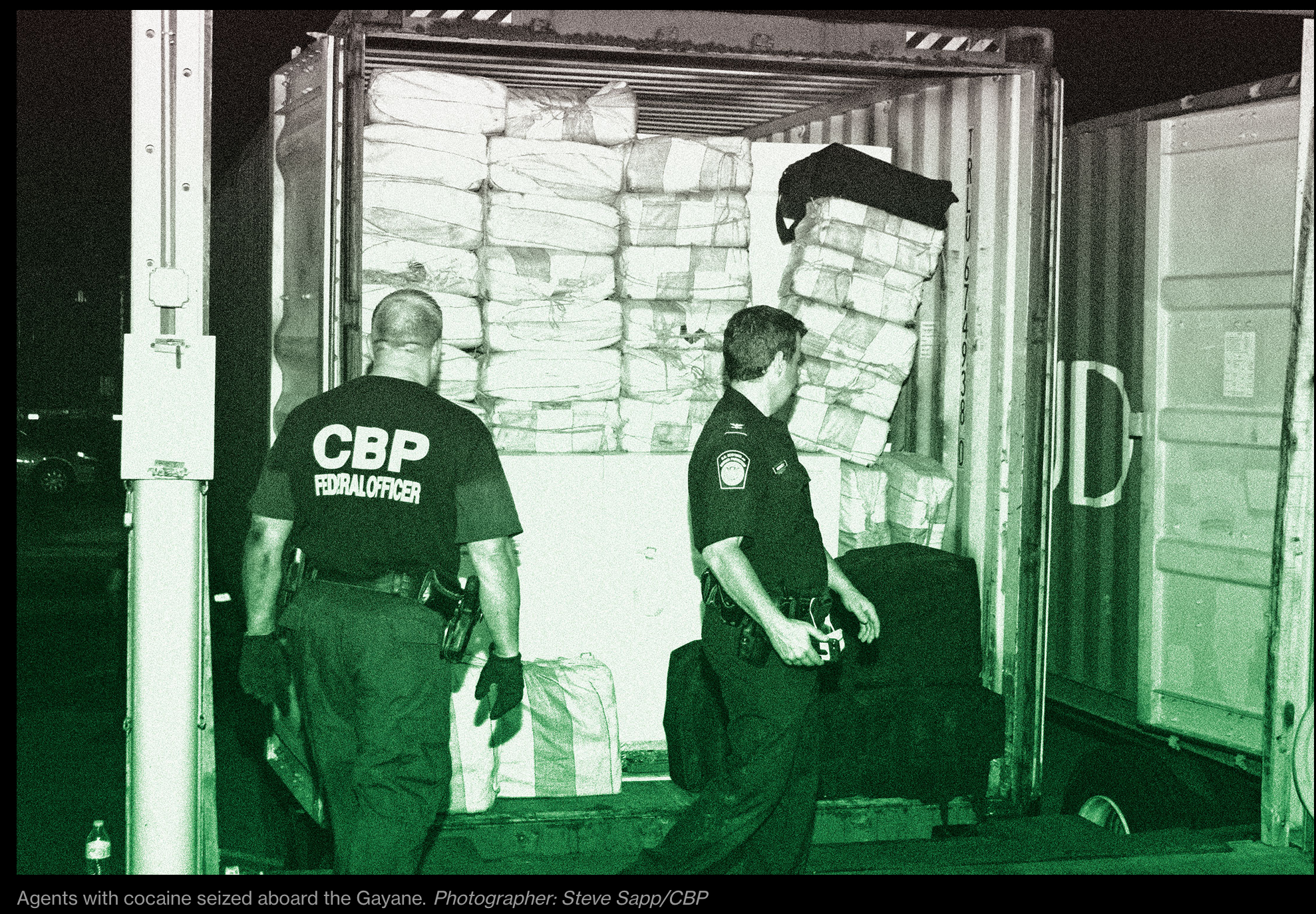
As MSC grew into a dominant force in global trade, it also became a prime drug-trafficking conduit for Balkan gangs.
In the summer of 2019, Claudio Bozzo, chief operating officer of MSC Mediterranean Shipping Co., flew 4,000 miles from Geneva to Washington, DC, for a meeting with US Customs and Border Protection. He’d been sent by MSC’s owner, a secretive 82-year-old billionaire named Gianluigi Aponte, to contain a crisis.
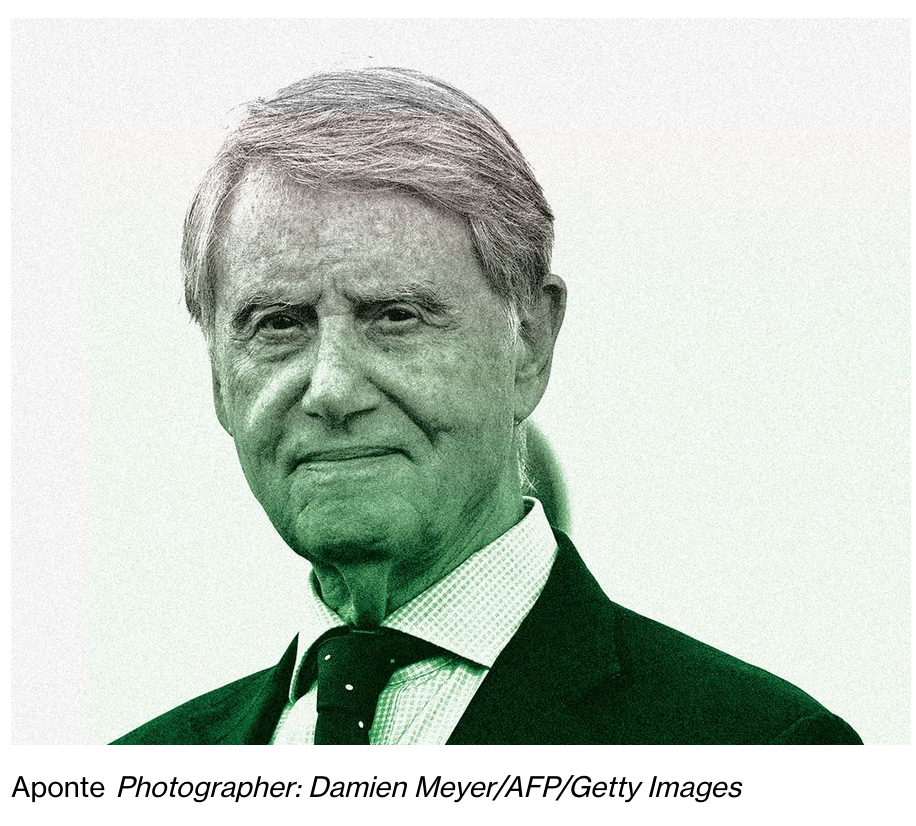
A few months earlier, more than 100 agents had boarded one of MSC’s ships, the Gayane, as it slid into the Port of Philadelphia for what was supposed to be a quick stop on its way to Rotterdam. Deep below deck, hidden in containers packed with wine and nuts, the agents discovered nearly 20 tons of cocaine, worth $1 billion.
The ensuing investigation showed that more than a third of the crew—all MSC employees—had helped transfer vast amounts of cocaine from speedboats at night while the ship powered through the open ocean off South America. It was the largest maritime drug bust in American history.
The crime was so big and brazen that authorities made the exceptional decision to seize not just the cocaine but also the Gayane itself, a 1,000-foot-long ship worth more than $100 million. During Bozzo’s meeting with the CBP in the limestone Ronald Reagan Building, he apologized for the ordeal and said the crew’s actions had come as a surprise, according to a person familiar with the events.
He extolled MSC’s growth from humble beginnings into the world’s largest shipping company and impressed upon the officials how seriously the Aponte family takes the responsibility of running a fleet that accounts for nearly 20% of all seaborne container trade.
For US officials, the company’s claim of ignorance didn’t add up. Years before the Gayane was boarded, law enforcement authorities in multiple countries had been monitoring MSC’s vessels and crews, a Bloomberg Businessweek investigation found.
US authorities had not only been tracking the Gayane long before it entered American waters, but they also had previously boarded and searched several other MSC ships as part of a broader investigation into an international cocaine trafficking ring that had burrowed into the shipping company.
Using clues collected during those boardings, as well as intelligence gathered in Eastern Europe, they identified the powerful Balkan Cartel as the architect behind the massive shipments. Authorities in the US and Europe also concluded that the syndicate, which controls more than half of the cocaine flowing into Europe, had infiltrated MSC’s crews over a decade, exploiting its manpower and vessels to help build a cocaine smuggling empire.
“We certainly didn’t see MSC as a victim in all this,” says William McSwain, former US attorney for the Eastern District of Pennsylvania, who presided over the Gayane case until he left the office in January 2021.
MSC and the US government are now locked in a legal battle that has taken place largely out of public view. Customs officials have been pressing the company to pay more than $700 million in penalties, according to multiple law enforcement sources who spoke on the condition of anonymity about the nonpublic administrative proceedings.
Prosecutors in the US Attorney’s Office for the Eastern District of Pennsylvania, meanwhile, are building a civil case arguing that MSC, as the operator of the Gayane, bears responsibility for the drug trafficking and must forfeit the vessel or a substantial portion of its value.
While MSC concedes that record amounts of cocaine were found aboard its ship, it disputes key aspects of the government’s version of events and argues that it was the victim of traffickers, not a co-conspirator.
A spokesman for MSC, Giles Broom, says that the company has always taken narcotrafficking seriously, but that the Gayane “incident showed a new level of security threat that we and, as far as we know, the container shipping industry were not yet ready to face.”
Today, he says, MSC is regarded as “by far the industry leader in anti-smuggling efforts.” Still, “there is a limit to what anybody should expect from a company and from civilians doing their job: We are not a law enforcement body and we are not mandated, resourced or trained to confront dangerous organized criminal groups.”
MSC Dominates Routes That Double As Cocaine Superhighways
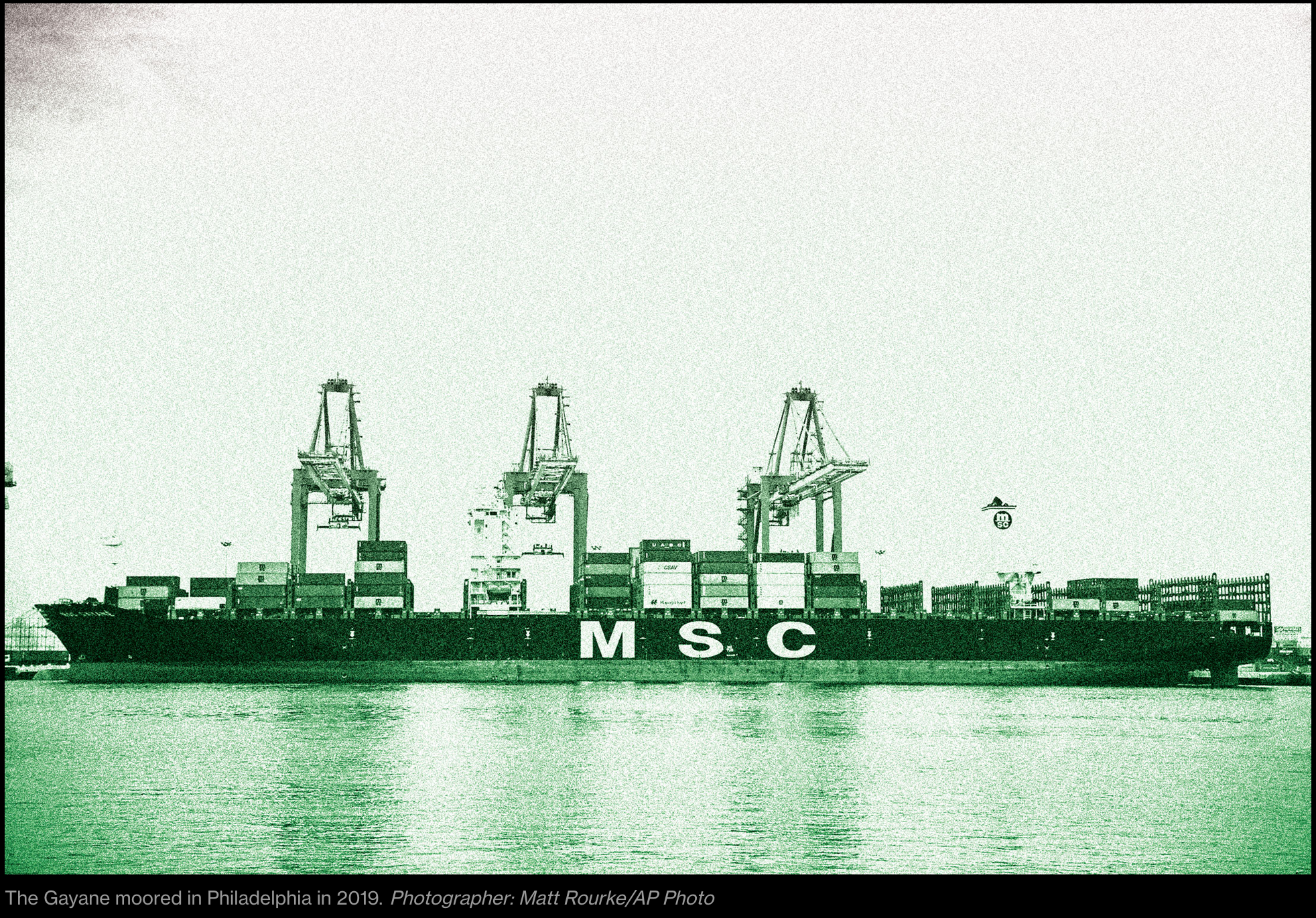
Businessweek’s investigation is based on interviews with more than 100 people in a dozen countries, including current and former law enforcement officials and people familiar with MSC’s business, as well as a review of trafficking cases in multiple countries. Many of the sources requested anonymity to discuss confidential details of ongoing or past investigations.
Every shipping company that runs routes from South America to Europe is at risk of being preyed on by cocaine traffickers. But MSC made for a uniquely attractive target, officials say. It dominates routes that double as cocaine superhighways, primarily those used to haul fresh fruit and vegetables from South America to Northern Europe.
It’s also the world’s largest employer of seafarers from Montenegro, a home to the Balkan Cartel. Years before the Gayane seizure, European police officials had warned MSC that its crews had been infiltrated. Yet the steps executives took to mitigate the problem fell woefully short, officials on both sides of the Atlantic say.
The situation has frustrated law enforcement and customs officials as record quantities of cocaine deluge global ports, especially in Europe. American prosecutors aren’t alleging that MSC’s leadership was involved in or benefited from the trafficking, but they’re trying to learn more about the breakdowns in the company’s hiring and security protocols, according to two senior officials involved.
Investigators in the US and Europe say they keep coming back to a central question: Why have criminal organizations apparently been able to control key operations aboard some of the company’s ships for so long? “How high the influence of the narcotraffickers lay within this company is unquestionably something that from Day 1 was of great interest to the US government,” says Robert Perez, who was deputy commissioner at CBP from 2018 to July 2021.
It’s rare for a shipping company to incur serious penalties for drugs found aboard its vessels. When fines are imposed in the US, regulators frequently let a carrier negotiate them down. In Europe, fines are rarely imposed at all.
Although there are international security requirements for shipping companies, customs and law enforcement officials have little power to hold the companies accountable. All of that has allowed the shipping industry, the primary engine of globalization, to escape major consequences as it has become increasingly entangled in drug trafficking.
Until the Gayane sailed into Philadelphia in the summer of 2019.
Despite the name, Mediterranean Shipping Co. is based far from the spray of the sea, in a quiet neighborhood of Geneva. Even in a notoriously insular industry, MSC’s inner workings are especially difficult to decipher. It’s one of the few major shipping companies that’s not publicly traded.
It operates a cruise line that publishes annual results, but its cargo business doesn’t release financial statements. Aponte also owns a maze of hundreds of related entities that oversee ferry operators, speedboat manufacturers, shipping terminals, even a private island in the Bahamas.
Aponte is slight, with a head of silver hair, icy eyes and an aristocratic bearing. He remains the chairman of MSC Group. His son, Diego, is president. His daughter, Alexa, is chief financial officer. Two years ago, following the Gayane seizure, he tapped Soren Toft, a longtime executive at rival AP Moller-Maersk A/S, to be chief executive officer of MSC’s cargo business, the first time an outsider has occupied the seat.
The family likes to say seawater runs through their veins, citing shipping documents from the 17th century that bear their name. Aponte was born in tiny Sant’Agnello, on the Bay of Naples; his family sailed goods and passengers across its waters.
He also became a seafarer, training as a ship captain and working under Achille Lauro, a former mayor of Naples and shipping magnate. He sailed on vaporetti that ferried wealthy tourists to nearby island resorts such as Capri and Ischia. It was on one of those trips that Aponte met his future wife, Rafaela Diamant, the daughter of a Swiss banker.
In 1970, Aponte purchased an old German break-bulk ship and started MSC. The following year he bought a second used vessel, naming it after his wife. He eventually began buying container ships.
When Aponte entered the business, shipping was dominated by legacy companies such as Maersk and Hapag-Lloyd, whose pedigrees dated to the 1800s. He carved out a niche by taking on underserved routes.
He also developed a shrewd business model, buying up secondhand container ships, some from scrap yards, then rehabbing them and sending them back out to sea. MSC also distinguished itself by emphasizing price over speed of delivery.
“MSC, very often in the early years, the inside joke in the industry was that it was shorthand for ‘maybe ship comes,’ ” says Lars Jensen, founder of the consulting firm Vespucci Maritime and a former executive for Maersk. “Your cargo would get there eventually, but you wouldn’t quite know when.”
These strategies allowed him to expand an empire almost entirely organically, rather than via acquisitions, as most of his rivals did. Over time, MSC added routes covering Asia, the US and South America, and by the early 2000s its motto was “Land covers one-third of the Earth—we cover the rest.”
But as Aponte was building MSC, a powerful criminal organization was building a maritime operation of its own.
Just after midnight on May 30, 2010, the MSC Oriane was cruising through the English Channel on its way to Antwerp, Belgium, when a nearby lobster fishing boat called the Galwad-Y-Mor began a series of odd maneuvers, moving first in front of, then behind, the giant cargo vessel.
As the Galwad approached, according to UK prosecutors, the Oriane’s crew tossed overboard 11 waterproof duffel bags containing a total of 255 kilos of cocaine worth about $80 million.
After collecting the duffels, the four men on the Galwad, including one from Montenegro, sailed to nearby Freshwater Bay, where they used metal weights to submerge the drugs and connect them to a buoy for later pickup by traffickers.
They never got the chance. UK antidrug police had been monitoring the operation, and they arrested the men on the Galwad, along with an accomplice. The following year, all five were sentenced to lengthy prison terms. The fishermen continue to maintain their innocence more than a decade later.
Behind the scenes, the incident triggered a European investigation into the infiltration of shipping companies by organized crime, according to a person familiar with the matter. Checking with police in Spain, Belgium and the Netherlands, UK authorities learned that the Oriane wasn’t a one-off.
Each of those countries had seen operations in which cocaine was carried across the Atlantic on commercial container ships owned by various companies, then transferred to smaller vessels before the cargo arrived in port.
These maneuvers, known as drop-offs, let traffickers avoid official ports of entry, where the chances of seizure were greater, but it meant they needed to recruit crew members aboard commercial cargo vessels, paying them to toss drugs over the side.
UK authorities took the case to Europol, which coordinates cross-border criminal probes among European Union members. Around 2012, agents from the UK, Spain, Belgium and the Netherlands met and agreed to gather all the information they had on drop-offs and to enter case details in Europol’s intelligence-sharing database. It emerged that while several major companies had been used, one name came up frequently: MSC.
Various European trafficking organizations used drop-offs, but they were known to be a specialty of the Balkan Cartel, a rising force in the international cocaine trade. The cartel is a constellation of gangs in five countries, bound by a common language, Serbo-Croatian.
Many began as private military groups during the Balkan War of the 1990s, pivoting afterward to weapons trafficking, cigarette smuggling, auto theft and money laundering. Among their ranks are ex-cops and former intelligence operatives.
Their factions cooperate but also compete. Some have gained a reputation for brutality—last year a police raid in a Belgrade suburb uncovered an industrial meat grinder with traces of human DNA.
Although the cartel operates all manner of criminal schemes, US officials say its revenue comes mainly from cocaine. The gangs are also innovators. In the early 2000s they began stitching together a logistics network that stretched across the Atlantic. In South America, they embedded members with producers, cultivating relationships right down to individual labs deep in the jungle.
In Europe, they built a wholesale distribution network. And in the early days, they sometimes filled out their supply chain by acquiring their own ships. Most of the time, the ships would transport legitimate loads of soybeans or other bulk commodities. For illicit loads, the traffickers would bring in a dirty captain and crew.
Then the Balkan Cartel doubled down on what current and former law enforcement officials say was a primary competitive advantage: Balkan sailors. Many came from Montenegro, a tiny nation on the Adriatic Sea that has a maritime tradition dating back centuries and several schools that train and accredit seafarers.
Even high schools there prepare students for a career at sea. This created a very attractive recruiting pool for the criminal gangs that were leveraging the high seas for their trafficking operations.
In many respects, the Oriane case had the telltale signs of earlier Balkan smuggling operations that used their own ships and crews. Now, to Europol investigators, it looked as though the traffickers had instead started planting their corrupt crews on the vessels of major shipping companies.
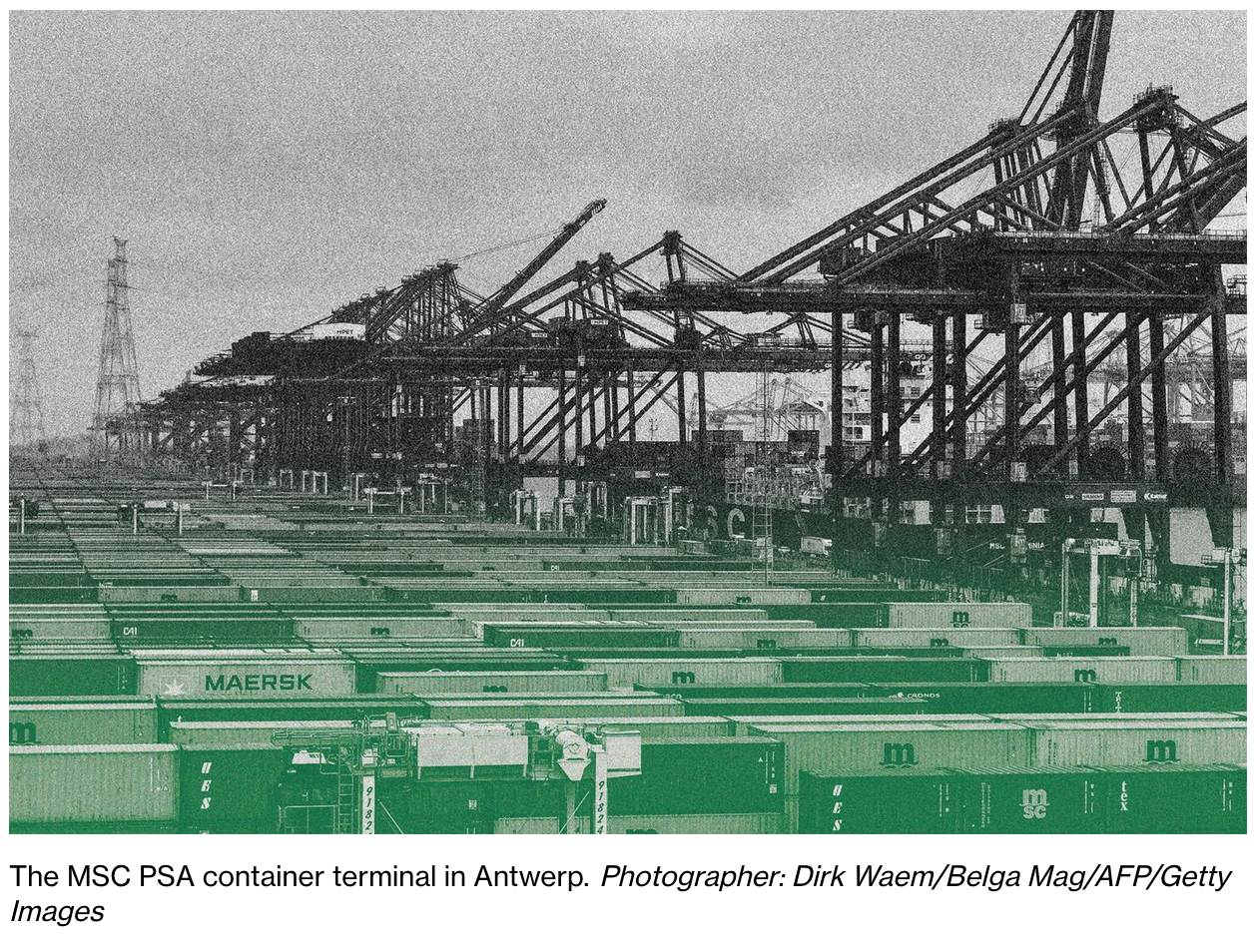
By 2013 other countries in Europe had come to suspect that the cartel had found a way into MSC’s crewing operation. The findings of their investigations were considered highly sensitive, but they occasionally emerged in public. That November the Montenegrin police directorate published a 100-page report on Balkan organized crime, a portion of which was dedicated to cocaine trafficking.
Gangs in the area, it read, “have developed networks of temporary members which usually consist of seafarers from Montenegro, Serbia and Croatia, who are mainly employed on container ships of the MSC company.”
The following year, Spanish police began tracking a gang of Montenegrin and Serbian traffickers who were arranging for cocaine shipments to be carried across the Atlantic on MSC ships and dropped by the crew off the coast of Europe.
Court records detail how the group’s contacts in South America controlled “an immense fleet of seamen hired from MSC ships” who could help traffic large quantities of cocaine to Northern Europe.
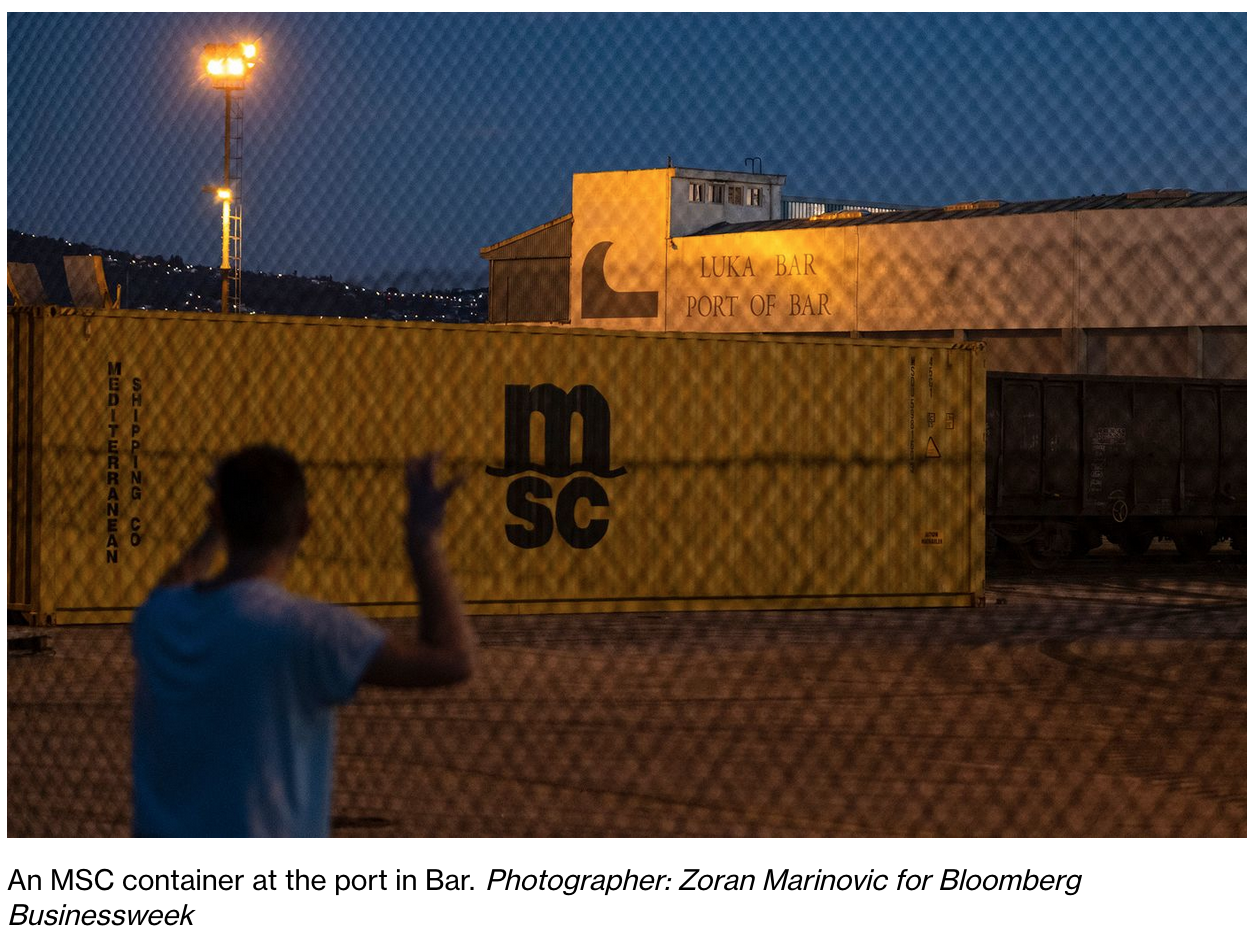
Another report from the Montenegrin police directorate, this one in 2015, said the main mode of cocaine smuggling for Balkan organized crime groups remained “container ships of the MSC company, covering the South America—Western European line.”
Around 2016, officers from the Netherlands, Belgium and the UK approached MSC’s management, with senior Dutch police taking the lead. They provided the company with select details gathered from the investigations and asked for help curbing the drop-offs.
MSC was told that the Balkan Cartel had used a crewing agency in the region to get corrupt sailors on board its ships, according to Jan Janse, police chief for the Port of Rotterdam, whose team was involved in the outreach.
The company also got a warning. “We told them what we saw. And we told them that it had to stop,” Janse says. “And if it wouldn’t stop, we told them that there would be the risk that we would do what the United States did later, which was seize their ships.”
It’s unclear what MSC did with the information. Broom, the spokesman, says the company doesn’t have a record of such a meeting taking place in Geneva in 2016. “MSC has met over many years with various customs and law enforcement authorities to discuss drug trafficking risks as part of our collaborations in many countries,” he says.
Janse says he believes the company took extra security measures and switched the crewing agency it used in the Balkans. Dutch antidrug police began to see fewer drop-offs, and the technique eventually disappeared almost entirely. But the smugglers only grew more sophisticated.
By 2016, record quantities of cocaine were arriving in Northern Europe, partly because of increased production in South America. There was evidence that traffickers were forgoing the customary passage through Spain in favor of large commercial container ports in Belgium and the Netherlands. For the first time, Belgium surpassed Spain as the country with the largest quantity of cocaine seized, according to an EU drug report.
The same year, Panama completed a $5.4 billion expansion of the Panama Canal. Formerly 33 meters (108 feet) at its narrowest, it was now at least 55 meters wide, granting access to supersize ships and tripling the volume of cargo that could pass through.
Businesses cheered the expansion, but Jürgen Stock, the secretary-general of Interpol, warned in a speech in Panama a month after the project’s completion that it could hasten the flow of cocaine across the Atlantic.
MSC began operating a route that capitalized on the enlarged canal. Several of its largest ships would load up on fruits and vegetables in Chile, Peru and Colombia, then make stopovers in the Bahamas and Philadelphia before crossing the Atlantic to the massive ports of Northern Europe.
Then they’d circle back. Port officials in Philadelphia dubbed the route the Philadelphia Express and said it would boost the local economy and transform the region into a major gateway for fresh produce on the East Coast.
Within months, MSC’s behemoth ships were snaking up the Delaware River, laden with blueberries, mangoes and asparagus. The company’s container capacity going from South America’s Pacific coast to Europe nearly tripled from June 2016 to June 2019, according to BlueWater Reporting. By 2019, MSC accounted for almost half of all container capacity on those routes.
MSC’s new routes ended up opening commercial opportunities for traffickers, as well. There’s an old drug agent adage: Smugglers are in the logistics business. Here, traffickers were able to gain many of the same efficiencies as established shipping companies simply by inserting their goods into the massive flow of containerized cargo.
Most of the cocaine that enters the US comes over land, through Mexico. But geography stipulates that Europe get it by air or by sea, and by 2016 most of it arrived there by commercial cargo ship.
As the cocaine surge to the continent turned into a crisis, European officials offered to share more information about seizures with their American counterparts. Immediately one fact stood out: Some ships known to have carried cocaine to Europe were stopping briefly in US ports. And some of those were MSC ships sailing through Philadelphia.
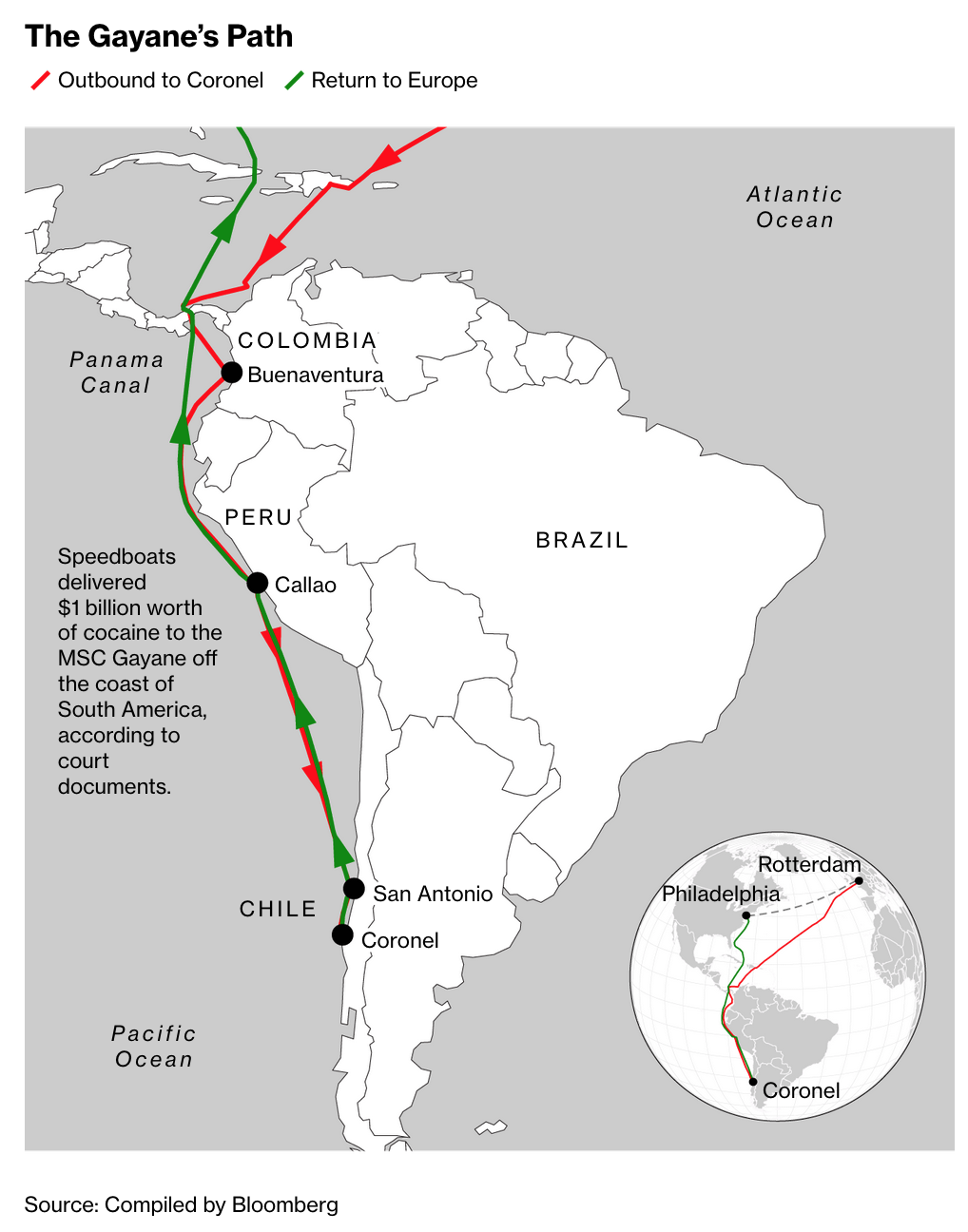
The main investigative arm of the US Department of Homeland Security, known as Homeland Security Investigations, began working with European partners to analyze major cocaine busts, especially those at the ports of Antwerp and Rotterdam. HSI agents tapped into data collected by customs authorities on shipping manifests and vessel movements in South America.
They learned that while Europe-bound cocaine had mostly come from South America’s east coast, especially from Brazil, over the past few years the trend had begun to shift. Now much of the cocaine heading to Europe originated in and around west coast ports, such as Callao in Peru and Guayaquil in Ecuador.
At first, investigators assumed the drug was being smuggled through traditional methods, such as hiding it alongside legitimate cargo that’s being packed at warehouses or farms, or the “blind hook,” in which accomplices break into containers and stash cocaine inside.
Beginning around 2017, HSI spent months trying to uncover the traffickers’ methods, first in Colombia and then Panama, according to two people familiar with the probe, but the agents kept hitting dead ends.
HSI, along with US customs agents, began boarding cargo vessels as they neared Philadelphia, examining crew quarters, engine rooms, even one ship’s propeller shaft, mostly without luck. But the searches also allowed them to isolate individual crew members in an effort to develop sources aboard the ships, according to one former senior US official.
By 2018, the official says, investigators had concluded that the traffickers weren’t using the traditional smuggling methods at all. Instead, they were using Balkan crew aboard MSC cargo vessels to load the drugs while the ships were at sea. Investigators worked every angle to get inside that network, tapping communications and cultivating informants. Finally, they had the opening they needed.
By the time Aleksandar Kavaja started preparing for his upcoming voyage aboard the MSC Gayane in the spring of 2019, his hometown of Bar, Montenegro, was an established recruiting ground for the Balkan Cartel. Locals say it wasn’t hard to guess which sailors might be in on the cocaine trade—they were likely the ones with Maseratis and new homes overlooking the Adriatic.
Bar, a small, ancient city dotted with beaches and olive groves, is home to Montenegro’s largest seaport, where MSC is ubiquitous. It’s a stop for the company’s cruise line, and MSC also operates a crew training center just to the north—one of four it runs worldwide, with the others in India, Italy and Ukraine. Of the 6,000 seafarers in Montenegro, about 2,250 work for MSC, according to Mimo Draskovic, head of the maritime management study program at the Faculty of Maritime Studies in Kotor.
Kavaja was among them. He’d grown up on the outskirts of Bar, on a farm that had been in his family for generations. His mother, Ranka, worked at a local soup kitchen, and his father, Radoslav, earned money by fashioning trinkets from seashells and selling them to tourists.
Aleksandar’s grandfather had been a sailor, so his family was thrilled when he graduated and landed a job with MSC. He would earn a salary of about €4,500 a month ($4,750), more than 10 times what his parents were earning. In 2015, at age 21, Aleksandar went to sea.
Over the next several years, he sailed on at least four MSC ships—the Lorena, the Diana, the Deila, the Erica—installing, wiring and repairing electrical equipment as the vessels made stops in South Korea, Panama, Malta and other far-flung places.
He didn’t love the job or the months away from his family. “He’s not a sailor at heart,” his mother says. But he was committed to supporting his family financially.
One day in mid-April 2019, Kavaja had lunch in a coffee shop in Bar. He was due to board the Gayane at the Port of Antwerp in a few days, for what would be his sixth journey aboard an MSC ship. After finishing his meal, he stepped outside and was approached by a man he didn’t know. “We know who you are, we know who your family is,” the man said, according to US court records. “We know that you’re going to leave on that ship in five days.”
The man held out a mobile “narco” phone, as prosecutors referred to it in court filings, and told Kavaja he had a choice. He could either take the phone and agree to follow orders, or he would risk his and his family’s safety. If he agreed, he would be paid $50,000, nearly a year’s salary.
He took the phone.
Two months before Kavaja set foot on the Gayane, drug agents got information that there was cocaine on board another MSC ship, the Carlotta, according to a person with knowledge of the probe. The ship was on its way to the port of Newark, New Jersey, which MSC sometimes uses as a backup to Philadelphia.
When the Carlotta arrived, agents searched the vessel and found 3,200 pounds of cocaine stashed in a container of dried fruit. It was the largest drug seizure in Newark in 25 years.
The load’s size garnered immediate attention, and resources poured into the investigation from HSI and the US Drug Enforcement Administration. Homeland Security agents in New York began working with the DEA’s international division, which had tracked the Balkan Cartel for years from its office in Croatia.
The Newark bust yielded fresh clues. Investigators collected data from some of the Carlotta’s refrigerated containers, which track sudden changes in interior temperature. The data indicated that some of the containers had been opened while the ship was underway. It “showed pretty clearly that something was going on at sea,” says a person familiar with the probe.
During the search of another MSC cargo ship that spring, agents found a small two-way radio in a crewman’s cabin, according to a person with knowledge of the discovery. The radio used a frequency typical of small craft, and the captain told investigators there was no reason the device should have been aboard a commercial cargo ship.
HSI questioned the crewman, who was from the Balkans, but he wasn’t arrested. During other searches, investigators found evidence that someone on board the ships had snipped a wire, overriding a device limiting the weight small cranes at the stern could lift.
A second major US seizure took place on March 19, this time on board the MSC Desiree in Philadelphia. Customs officials found more than a half ton of cocaine, the largest amount seized in Philadelphia in almost two decades. Agents ultimately identified at least four MSC ships where they believed crew members were involved in smuggling cocaine: the Carlotta and the Desiree, plus the Avni and the Gayane.
The story the crew told about hoisting five elephants’ worth of cocaine off speedboats seemed far-fetched
US agents weren’t the only ones finding drugs. In April, Peruvian authorities discovered 2.4 tons of cocaine stuffed into 64 suitcases and bags aboard the Carlotta, which had apparently gone right back to carrying drugs. Authorities in Panama then found 1.3 tons of cocaine during a search of the Avni.
(American investigators had also suspected that cocaine was on the ship and planned to search it in Philadelphia, according to two people familiar with the investigation, but the Panamanians beat them to it.)
The crew members’ roles on the vessels gave the traffickers a huge advantage. The sailors had access to key data, such as container locations and destinations, which investigators later said allowed them to pick boxes that had room to stash large amounts of cocaine and that were less likely to trigger a customs search once they arrived in port.
That posed an enormous challenge for US authorities, since drugs could be located virtually anywhere in a sea of boxes on the ship.
Searching a fully loaded ship is difficult, so much so that it’s rarely done. Holds are cramped and containers can be difficult to get to. The agents acquired special oxygen monitoring devices in case they had to go deep beneath the deck, where rusted iron can deplete oxygen levels. They assembled a group of drug-sniffing dogs and obtained cameras that could be snaked into a loaded container to find cocaine.
The agents also began quietly briefing the partners they’d need to conduct a full vessel search: the US Coast Guard, the Delaware State Police, Philadelphia city cops, even a maritime-trained SWAT team. All they lacked was the last-minute intelligence that would tell them which ship to search. By the time the Gayane arrived in Philadelphia that June, everything was in place.
As the Gayane was sailing southbound from Panama, Kavaja’s narco phone rang. When he picked up, according to his lawyer, a man told him to report to the upper deck. Kavaja did so and found other crew members there waiting.
Court records show that three others had been recruited in Montenegro before boarding the ship. Kavaja’s role was to phone traffickers carrying cocaine on speedboats and communicate the Gayane’s position so they could locate it at night.
He also recruited others to help move the heavy loads. In total, at least 8 of the 22 crew members aboard the Gayane—6 from Montenegro, 2 from Samoa—handled the job. Each stood to make $50,000 or substantially more, depending on their role.
While the Gayane was just off the coast of Peru, according to court records, a Montenegrin seafarer named Bosko Markovic helped assemble the crew members, who waited on the deck alongside four men in ski masks. Markovic was the ship’s first officer, one rank below the captain and in charge of the cargo and deck crew. A speedboat had just pulled up alongside the hulking vessel.
Another Montenegrin, Ivan Durasevic, the ship’s second mate and third in command, operated a small crane, hoisting up giant nets stuffed with black duffel bags and bales of cocaine. Once the nets were on deck, the other crew pushed the drugs to a hold on the vessel. The men broke into a series of containers by cutting the security seal on each one.
After stashing the cocaine inside, they resecured the containers with a fake seal, complete with the MSC logo. Sometimes they had to cut steel cables or bend metal railings to squeeze in the cocaine, then use welding irons and paint to disguise the damage.
Over the next several nights, as the Gayane sailed south, the ship was met by at least six speedboats, according to court records. It never stopped moving. It didn’t even appear to slow down, according to law enforcement officials. The job was carried out as the vessel powered through the open ocean—an incredible feat of seamanship.
By June, the Gayane had made its southernmost stop, at a small port in the Bay of Concepción near Coronel, Chile, and begun the return journey. When the vessel hit the coast of Peru again and made its northbound journey to Panama, it was approached by at least eight more speedboats. The nighttime hoisting and heaving resumed.
On the afternoon of June 16, the Gayane was in US territorial waters, bound for Philadelphia. As it entered Delaware Bay, the Coast Guard contacted the captain and directed the ship to head for an area called Big Stone Anchorage. Commercial vessels normally stop there to await an authorized riverboat captain who can navigate a local channel.
But as the Gayane pulled in, three patrol boats and a helicopter approached the ship, and a team of law enforcement officers ascended its Jacob’s ladder.
Some agents rounded up crew in the galley, while others headed for the bridge to find schematics for the vessel. The search for drugs started with the above-deck containers while the Gayane was still in the bay. At around 3 a.m. on June 17, the ship reached Philadelphia’s Packer Avenue Marine Terminal, within view of the spring-green Walt Whitman Bridge.
More than 100 agents were waiting. They believed there was cocaine on board, but they didn’t know where it was. A team began swabbing the crew’s hands for traces of the drug. Several tested positive.
At around 7 a.m., just as the sun rose over the bay, agents got their first strike: a stash of bricks tucked into burlap sacks inside a container. Joseph Martella, CBP’s port director, was off the day the Gayane arrived in Philadelphia, but he was carefully monitoring his phone and headed to the port.
Just after 10 a.m., a second container full of cocaine was found. Martella then made the unusual decision to offload and physically inspect every one of the 4,000 containers on the ship.
After nearly a week of work, the government had dug through loads of wine, dried nuts and scrap batteries to identify seven containers that carried cocaine. Customs officials spent days weighing the drugs, counting the bricks and logging it all into evidence. At one point, as the agents rushed to finish their task, they looked around and saw white dust everywhere, Martella recalls. One of the agents realized it wasn’t ordinary dust and instructed everybody to mask up.
In total, the haul consisted of more than 15,000 bricks of cocaine, weighing nearly 20 tons and with an estimated street value exceeding $1 billion. The authorities were alarmed not only by the sheer quantity of drugs but also by the audacity of the operation.
The leader of the onboard scheme, the first officer, had been in charge of the crew’s schedule, allowing the co-conspirators to be on duty at the same time. And both he and the second officer had access to key details about the containers, according to court records. (The captain of the Gayane was questioned by a grand jury but never arrested or charged.)
On June 18, two days after the Gayane was detained, MSC released a public statement. “MSC Mediterranean Shipping Company is aware of reports of an incident at the Port of Philadelphia in which US authorities made a seizure of illicit cargo,” it said.
“MSC takes this matter very seriously and is grateful to the authorities for identifying any suspected abuse of its services. Unfortunately, shipping and logistics companies are from time to time affected by trafficking problems.”
Over the following 10 days, agents continued to interview the crew members, who remained sequestered on the ship. They pulled the sailors off one at a time, interviewing them for hours as they pieced the operation together. At first, the story the crew told about hoisting five elephants’ worth of cocaine off speedboats while the ship coursed through the waves seemed far-fetched.
But prosecutors obtained a warrant to seize the ship’s voyage data recorder, which contained information on the vessel and its movements, and on it they found radar images indicating the various points at which small boats had approached the Gayane and remained alongside, three officials say.
Seizing a ship is an extreme measure, but the revelations about the crew members’ involvement in trafficking so much cocaine emboldened authorities. On the morning of July 4, CBP agents boarded the Gayane and handed the captain a seizure warrant. At nearly the same moment, notice of the seizure was emailed to MSC executives.
“When a vessel brings such an outrageous amount of deadly drugs into Philadelphia waters, my office and our agency partners will pursue the most severe consequences possible,” said US Attorney McSwain in an announcement.
MSC moved swiftly to get its very expensive cargo ship sailing again. In exchange for a $10 million cash payment, as well as a $40 million bond and promises that the company would cooperate with any ongoing investigation, the Gayane was allowed to continue to its original destination of Rotterdam. On July 13, almost a month after being detained, the ship was out on bail.
By the time Bozzo, the MSC executive, arrived in Washington on Aug. 27, the potential for long-term harm to the company was mounting. Customs officials had suspended the “trusted trader” status granted to MSC under a Sept. 11-era program that allows carriers to avoid lengthy screenings and delays at American ports in exchange for observing certain security protocols.
Meanwhile, prosecutors in the Eastern District of Pennsylvania brought criminal charges against the eight crew members, including Kavaja and the first and second officers.
All of them would eventually plead guilty and be sentenced to time in federal prison. Behind the scenes, American authorities identified a faction of the Balkan Cartel that had financed and organized the operation, learning that the gang had brought in partners from Colombia and Northern Europe to share the risk.
So many groups had a share of the Gayane’s cocaine that one American law enforcement official described it as the trafficking equivalent of an Amazon truck.
Over the next several months the government entered discussions with MSC, with the aim of getting it to agree to new security measures, such as rotating crews more frequently and requiring them to take polygraph tests.
In exchange, the US government held out the prospect that it would substantially reduce the fines MSC was facing. Including the earlier seizures aboard the Carlotta and the Desiree, those now totaled more than $700 million, based on the statutory penalty of $1,000 per ounce of cocaine.
The focus of federal prosecutors now shifted to a civil forfeiture investigation—a step designed to recover proceeds used in the commission of a crime. Although the use of the Gayane in a crime was an established fact, MSC could mount an “innocent owner” defense. It would require the company to show that it couldn’t have anticipated the use of its vessel to traffic cocaine or that it had taken reasonable steps to prevent such conduct.
By the fall of 2020, it had become clear that MSC wasn’t ready to strike a deal with the government. The company informed CBP that it planned to contest the penalties connected to the Gayane, as well as the Carlotta and the Desiree. Company lawyers also presented customs officials with findings of an internal investigation it had conducted.
“MSC does not dispute that US authorities found almost 20 tonnes of cocaine at the Port of Philadelphia,” says Broom, the company spokesman.
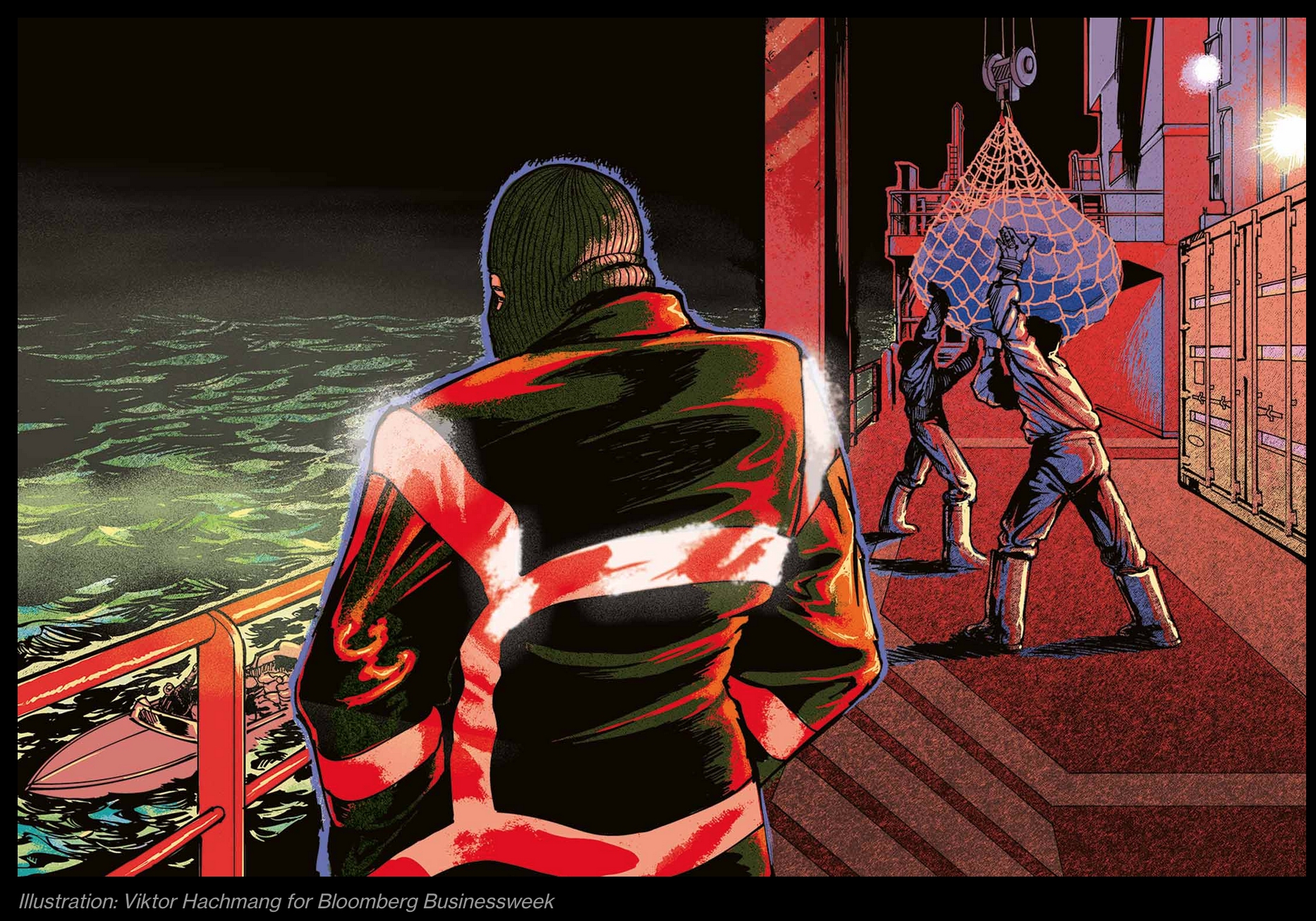
“But MSC’s investigation has led us to the conclusion that the majority of that cocaine was not, and could not have been, loaded at sea.” MSC didn’t give further details about where and how it believes the drugs were loaded.
If the company were to demonstrate that some portion of the cocaine was loaded on land, indicating that its employees played a lesser role in the scheme, the government could have a more difficult time justifying harsh penalties. It could also serve as evidence if the forfeiture matter ever went to trial.
According to one US official involved in the investigation, though, MSC’s claims contradict facts already established in court as part of the crew’s guilty pleas and sentencing proceedings. “That position is directly at odds with the factual findings of the court,” the official says.
The government is also pursuing a wider criminal investigation against members of the Balkan Cartel who are believed to have orchestrated the Gayane operation. On Oct. 30, Goran Gogic, a Montenegrin former heavyweight boxer, was apprehended at Miami International Airport before he could board a flight to Switzerland.
In an indictment, prosecutors accused him of organizing logistics for cocaine smuggling aboard commercial container ships on behalf of the Balkan Cartel, including on the Carlotta, the Desiree and the Gayane.
According to one person familiar with the investigation, Gogic is “probably two or three levels down from the person who pulled all this together.” Gogic’s attorney says his client maintains his innocence.
The Gayane ordeal could serve as an inflection point for the industry. Janse, the Dutch police official, likens the situation to the one faced by banks two decades ago, when regulations across multiple countries forced them to better track the criminal activities of their clients and adhere to strict compliance standards.
It was a profound change in the way they did business, and it cost them billions of dollars. “I was involved in combating money laundering 30 years ago, and all the banks used to say that they couldn’t look at clients’ money and say it comes from criminality,” Janse says. “None of them say that now. And that’s the thing we have to do with all the shipping companies.”
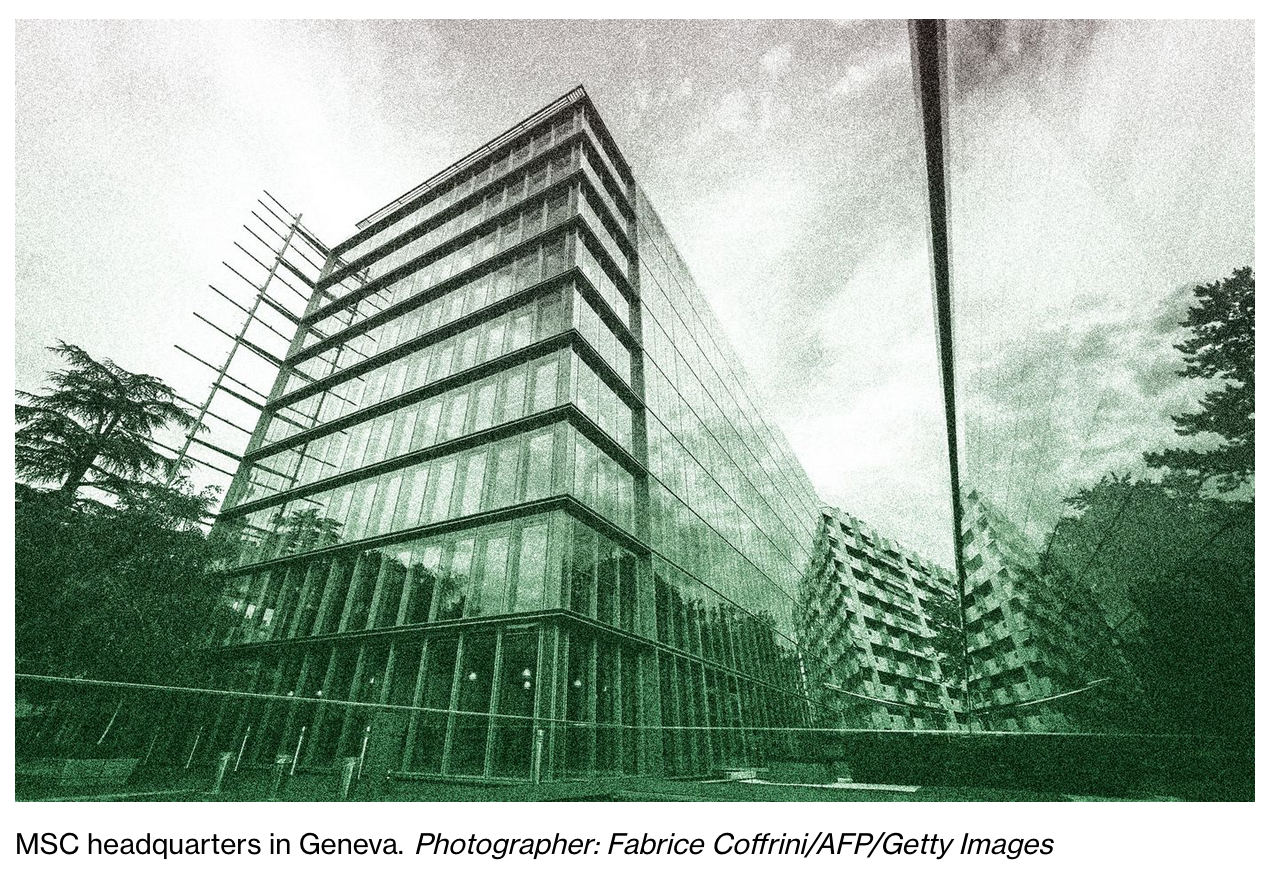
If there were ever a moment for shipping companies to spend more money to curb trafficking aboard their vessels, now would be it. When demand for consumer goods rebounded from the initial pandemic crash, cargo prices surged, and the companies enjoyed a once-in-a-generation windfall.
They pulled in a record $217 billion in profit in 2021 and are on track to make $275 billion this year, according to Drewry Shipping Consultants Ltd. Aponte’s personal wealth more than doubled during the pandemic, to $19 billion, according to the Bloomberg Billionaires Index.
And MSC went on a ship-buying spree, purchasing 128 secondhand container ships between 2020 and 2021, expanding its fleet to 645 and passing Maersk as the leading shipping line, according to industry data provider Alphaliner.
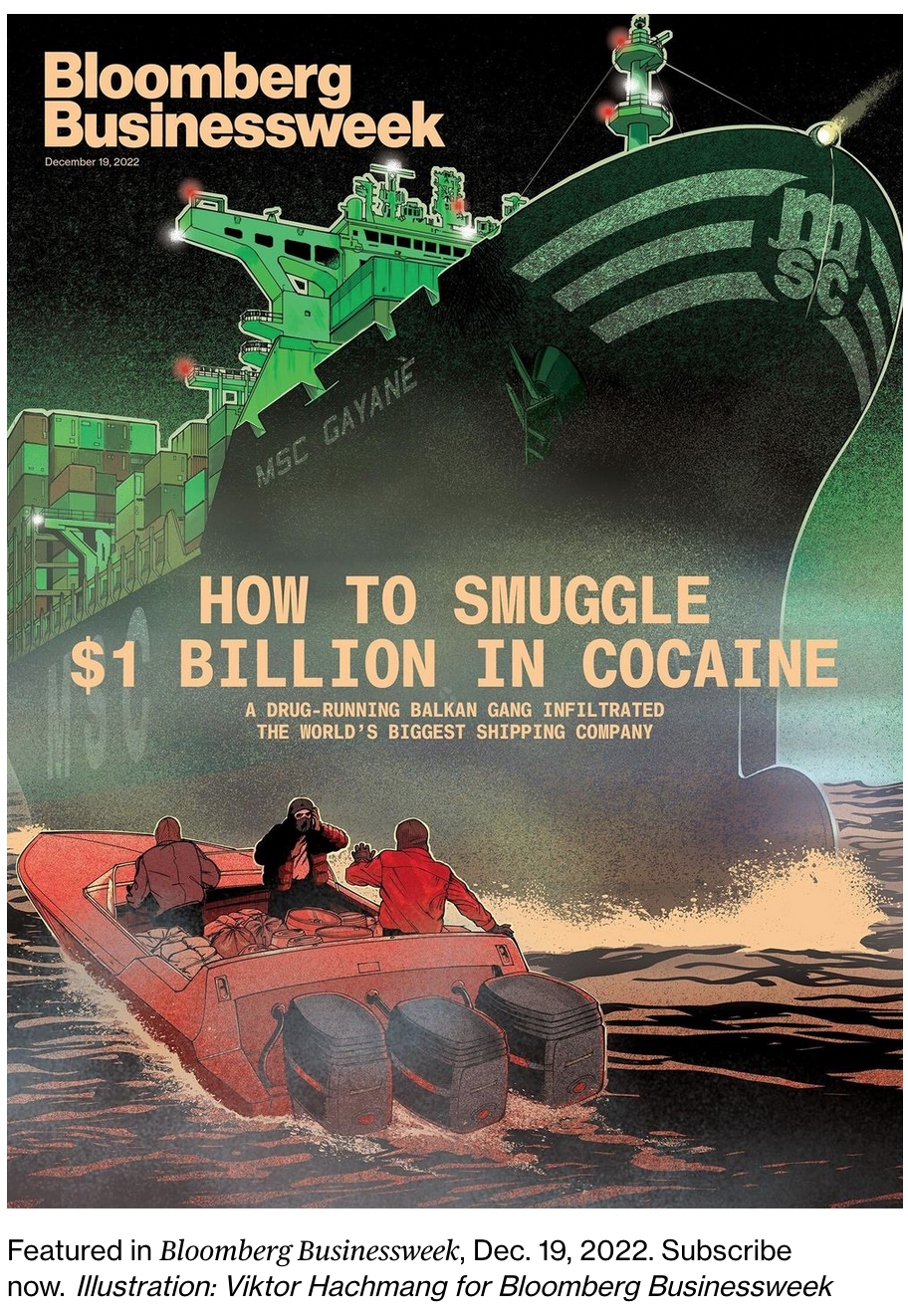
While MSC says it has long taken security seriously, it concedes that the Gayane was a “wake-up call.” After the incident, the company said it would spend $100 million over five years on anti-smuggling security upgrades. It says it now uses guard patrols on vessels sailing along the west coast of South America, drug-sniffing dogs at high-risk ports and remotely monitored cameras on its vessels.
Earlier this year, Bozzo, the chief operating officer, helped arrange an industry-sponsored conference with the United Nations and the World Customs Organization to discuss ways to better tackle narcotics trafficking. And MSC has made one other big change, according to a person familiar with its internal decision-making: Montenegrin seafarers are no longer used on its ships crossing the Panama Canal.

Meanwhile, the Gayane continues to navigate the world’s oceans. It stopped recently in Thailand, Saudi Arabia, Egypt and Portugal—far from the sea lanes of South America.
Related Articles:
JPMorgan Scams Investors With Phantom Yields In EMBI Indexes (#GotBitcoin?)
JP Morgan Again Displays Schizophrenic Love-Hate Relationship Towards Crypt-Currency (#GotBitcoin?)
JPMorgan Will Pilot ‘JPM Coin’ Stablecoin By End of 2019: Report (#GotBitcoin?)
JPMorgan’s New App Service For Young People Fails (#GotBitcoin?)
JPMorgan Chase With It’s JPM ShitCoin Wants To Take On Bitcoin (#GotBitcoin?)
Christine Lagarde Pits Circle Against JPMorgan In IMF Debate (#GotBitcoin?)
Citigroup, JPMorgan Chase And Others Fined $1.2 Billion Over FX Trading (#GotBitcoin?)
Wells Fargo, Ford, JPMorgan Chase, Verizon, Etc. To Lay-off 100,000+ Employees (#GotBitcoin?)
SEC Grants $50 Million Award To Two JPMorgan Whistleblowers (#GotBitcoin?)
U.S. Market-Manipulation Cases Reach Record (#GotBitcoin?)
Wall Street Fines Rose in 2018, Boosted By Foreign Bribery Cases (#GotBitcoin?)

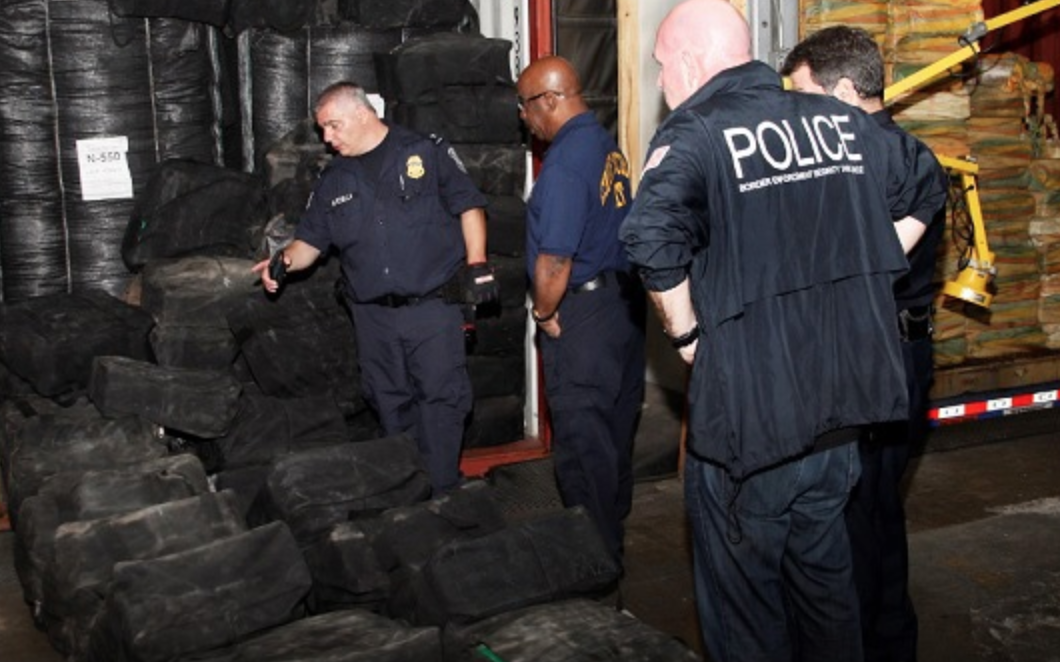

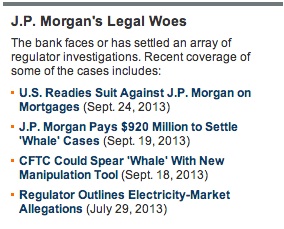
Leave a Reply
You must be logged in to post a comment.